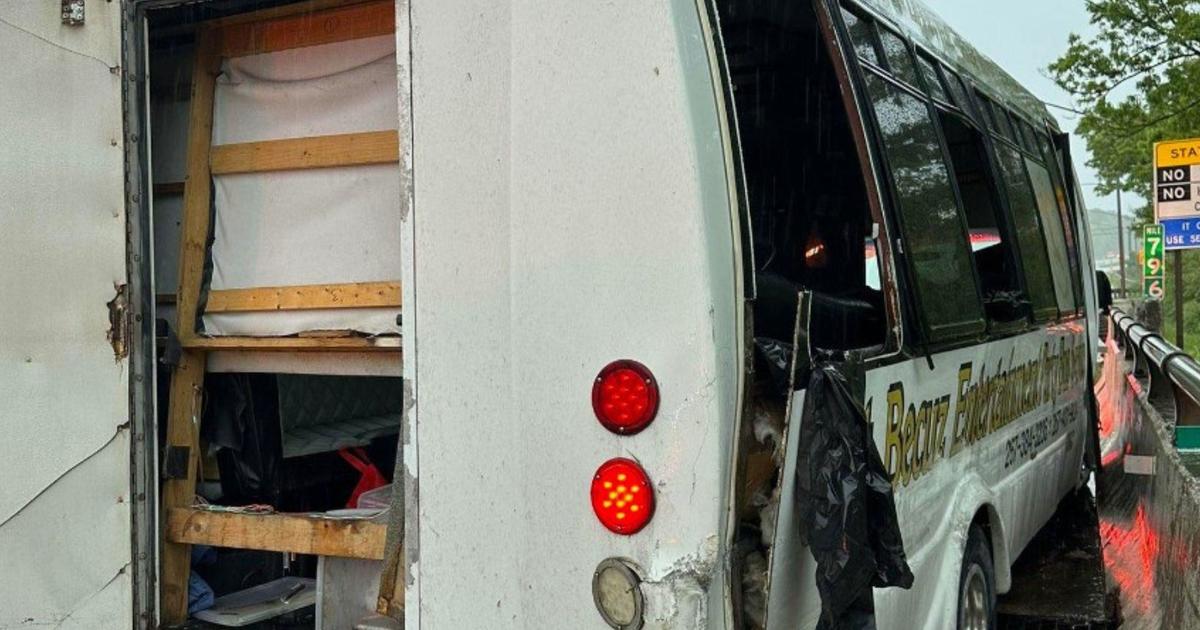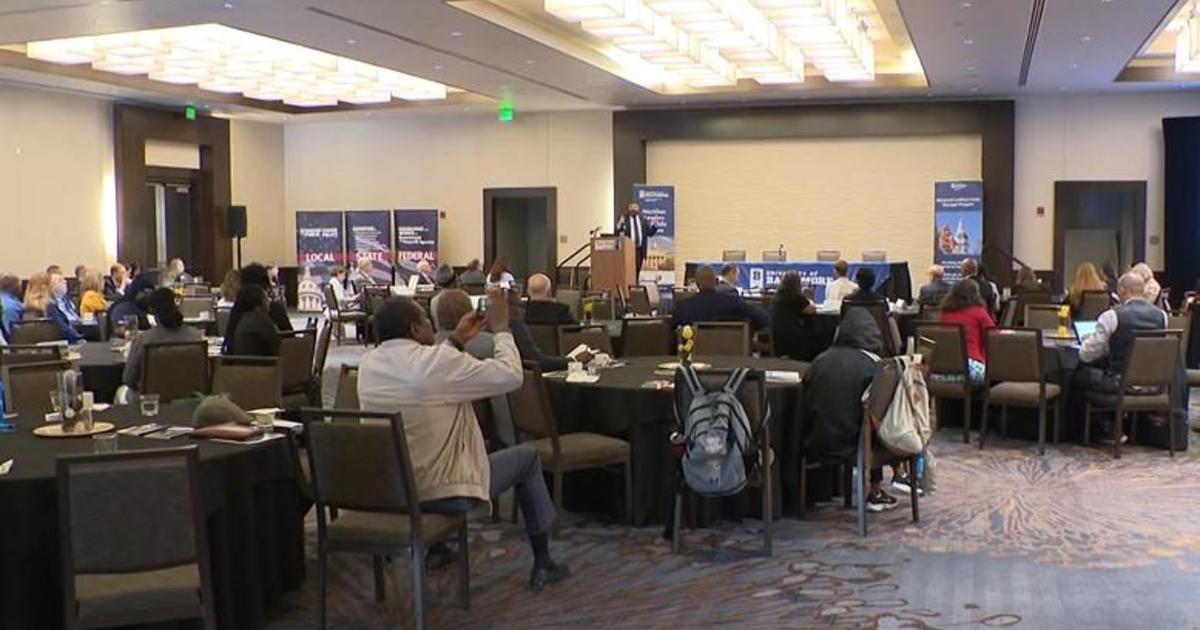Shepherdstown Gets Branch Of Running Group
SHARPSBURG, Md. (AP) -- It's not too often that a group of runners meets at a pub to start the day's run.
But it's typical for the Panhandle Hash House Harriers, who meet in and around Shepherdstown, W.Va., to run and socialize. And runs are usually in the evening, not the morning.
While a lot of drinking is not encouraged, a relaxed attitude to running definitely is. This is not the time to show up with your Garmin watch and a planned pace.
Dustin Jones, a physical therapist who recently moved to Martinsburg, W.Va., decided to start a chapter of the international Hash House Harriers because Shepherdstown has become a meeting place for many runners. The presence of Two Rivers Treads and its affiliate Natural Running Center has attracted runners nationally and internationally.
Last week, more than a dozen runners met at Captain Bender's Tavern, a popular bar in Sharpsburg, a few miles from
Shepherdstown. The runners got a Chalk Talk, sort of like a pep talk, from "Thang," a member of the Hillbilly Hash House Harriers in northern Virginia. Members of this established group have gladly lent their "expertise" to help the Panhandle runners get started.
Nicknames like Thang's are part of the hash running experience.
Jones and fellow running pal John Bozek started the Panhandle group in January as a way for runners to meet fellow runners. In hash running, or hashing as it's called, the runners must follow clues to figure out where they're running next. So they must work together.
Kylene Haskins, of Ranson, W.Va., liked the fact that she wouldn't just be running.
"There's a purpose, a goal," she said. "I'm branching out, trying new things." She doesn't enjoy running just to run, she said.
Aaron McLaughlin, of Kearneysville, W.Va., said Haskins suggested he try hashing.
"I've been trying to get into shape," he said.
McLaughlin is a doctor at Harpers Ferry Family Medicine, while Haskins is a resident at WVUH-East Hospital.
Wynee Lou, a medical student living in Martinsburg, W.Va., said she likes being active in sports, and the game aspect of hashing appealed to her.
"This gets me motivated to come out and run," she said.
Hashing is for runners of any ability, in any physical condition.
"We were hesitant at first," she said. "John (Bozek) is a serious runner."
But Bozek and Jones insisted that hashing is for anyone. Jones would like to start a family-friendly hash for parents and children, and keep the adults-only hash for those who would like to imbibe (a little).
Each hash starts with a hare, or a leader, collecting dues, followed by the chalk talk. Dues are simply what you can afford, but runners are asked to give $2 to $5 to cover expenses. Markings are made with flour and washable chalk, and runners, or hounds, must follow the markings made by the harriers. In true hash tradition, however, the markings are a little vague. Hounds will split up, following leads until the group determines the correct path.
Hounds run through alleys, down public streets, through parkland and public trails. Circles of white flour mean the hounds are on the right trail. They stick to public lands unless permission has been given from private property owners.
They may run through fields, streams and briars. After all, they are hounds, chasing hares. Hare and hound lingo permeates hashing. Each chapter of the worldwide organization is called a kennel.
Hounds keep their noses down, searching for colorful clues, treasure-hunt style, which can pop up anytime, anywhere.
Rhyming notes, meant to give clues to the hounds, may be more confusing than informative. Several hounds carry large Crayola chalks, to let other hounds know when they've found the actual trail.
"If you don't know where you're going, just follow," said Thang. The hounds sprinted down a couple of Sharpsburg alleys
before making their way to the cemetery of Antietam National Battlefield. Here there were no markings, and the hounds quietly crossed the cemetery and into a farm field on the battlefield.
Although some sprinting is involved, there's plenty of time to recover at the numerous stops.
As the hounds made their way onto a paved park road, they sent scouts out to determine the direction of the trail. Eventually, the hounds made their way into a secluded spot. There they retrieved a hidden bag containing the ingredients for a toast.
IDs are checked before anyone can drink, and so must be tucked into running gear. A couple of more stops allowed the hounds to enjoy a little beer and water, and at one stop, there was cake. Birthday celebrations are simply an excuse for the hounds to enjoy a little cake.
At the close of the hash, the hounds had run about five miles, give or take. It probably took an hour and a half, but no one was really checking. Ice cream at Nutter's awaited, as did a meal at Captain Benders, for those who wanted to socialize.
Hash House Harriers formally began in 1938 in Kuala Lampur, Malaysia, when British expatriate Albert Stephen Ignatius Gisbert gathered a group of fellow expats looking for a way to keep active and socialize. They named themselves after a local club that was known as the Hash House because of its lackluster food. Since then, hashing has expanded to 1,800 kennels, including nearly every major city worldwide.
The hares and hounds of hash tradition stem from an old English children's game of chase. The sport of cross-country, which became popular in 19th-century Britain, incorporated this game. As the British empire spread across the globe, this tradition spread with it.
The Hash House Harriers are no stranger to tradition. "On, on" is called out when the trail is sighted. "Check" means search for the right trail. This also gives the slower runners time to catch up to the faster ones.
War and political unrest slowed the spread of the Hash House Harriers for a few decades, but by 1973, there were 35 known kennels around the world. In the 1980s, the popularity took off when hundreds of kennels were established.
Each kennel has a trailmaster, aka hare raiser, a hash master or a grand master. Scheduled runs with hares are known as harelines.
First-time hashers are known as virgins, and virgins are asked to make up their own trail names. Insults are down-downs. A few terms aren't really suitable for a family newspaper.
The terminology is universal, and hashers often travel to run with groups in other areas. Thang mentioned he would be traveling to Chicago on business this week, and would make time to run with a local hash group.
Jones hopes the Panhandle Harriers will become a local institution, appealing to runners of all ages and abilities.
"I'm not too competitive," he said. "I don't do a lot of races. I like to have fun, and running is fun for me. I don't log a lot of miles. I like efficient movement."
Although there's a little beer involved, running is healthy.
"Our group is evolving," Jones said.
Hash breaks can get creative, with dancing sometimes encouraged.
"Our group likes to take people through local businesses," he said.
The hare has the job of planning the route and informing local businesses that the hashers will be coming.
Tony Williams, who owns Mellow Moods Cafe and Juice Bar in Shepherdstown, is one of those business owners who welcomes hashers. He also occasionally is a hasher.
"It's all about making this place a better place for people to live," he said.
Jones and Bozek have dubbed the family-friendly hash, which will begin in June or July, the Diaper Dash Hash.
"We want it to be sustainable," he said. "We're not a drinking group, but we like to have fun. We want to play like a kid
again and get in shape."
(Copyright 2012 by The Associated Press. All Rights Reserved.)



